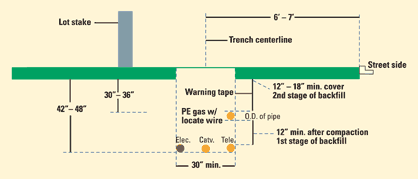Joint Trench Utility Installation
Guidelines and checklist
Whether you need installation of a natural gas main or a natural gas service line, you can save time and money by planning ahead for joint trench utility installation. It allows your utility companies to collaborate and share the same trench for:
Natural gas
Electricity
-
Telephone
Cable television
You should request joint trench utility installation as soon as the plat is available.
Please note: Joint trench service is not available in all areas. Contact the New Construction Hotline at 612-342-5123 (1-800-342-4166) to find out if it's available in your area.
How to prepare for joint trench utility installation
These requirements must be met before we can begin. Use this checklist as your guide.
You must provide all utilities with applications and final plats.
All large utilities must be installed (water and sewer, including storm drain, curbs and gutters).
Installation site must be within six inches of final grade.
All block numbers and lot corners must be staked and clearly marked so your electric utility will know where to install their transformers.
If curbs are required by the city, they must be installed with the first layer of blacktop. If curbs are not required, the area must have Class 5 grade and the first lift of blacktop must be installed.
Conduit crossings must be installed under roadways with the ends clearly marked (if applicable).
Verify that utility locations do not conflict with driveways, sidewalks, garages, fire hydrants, etc.
The area between roadways, property lines and utility easements must be clear (if applicable). We will place soil in this space during the installation.
Boulevards in installation area must be clear of topsoil or straw.
An 8' wide, obstruction-free path must be clear for a 48-hour period to allow our crews to work on the gas main route. You must notify your builders of installation date so they can clear path of all trash bins, construction materials, silt fences, etc.
You must mark all privately-owned underground facilities, including but not limited to: septic tanks, drain fields, sewer lines, sump pump extensions, water wells, sprinkler systems, invisible fences, electric lines, and pipelines.
CenterPoint Energy and the other joint trench utilities are not responsible for damage to these items if they are not clearly marked at the time of installation.
After installation, no concrete or pavement (such as sidewalks or bike paths) may be laid above the joint trench as with any utility installation.

Actual installation configurations may vary due to unique construction requirements.
How to prepare for joint trench service line installation
These requirements must be met before we can begin. Use this checklist as your guide.
You must provide all utilities with service applications and final plats. Check the joint trench indicator on the Natural Gas Service agreement.
Natural gas and electric meters must be on the same side of the building.
All privately-owned underground facilities must be clearly marked, including but not limited to: septic tanks, drain fields, sewer lines, sump pump extensions, water wells, sprinkler systems, invisible fences, electric lines, and pipelines.
CenterPoint Energy and the other joint trench utilities are not responsible for damage to these items if they are not clearly marked at time of installation.
For more information call us at 612-342-5123 (1-800-342-4166) or fax 612-321-5442 (1-800-365-9188).